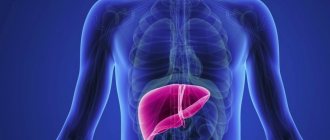List of indicators
Liver tests are a section of the biochemical panel of laboratory tests, the basis of which is a blood test. They include a range of indicators such as:
- Alanine aminotransferase (ALT), aspartate aminotransferase (AST).
- Gamma glutamyl transferase (GGT).
- Alkaline phosphatase (ALP).
- Bilirubin (total, direct, indirect).
- General protein.
- Albumen.
Sedimentary samples can be used to assess protein content: thymol, sublimate, etc. Previously, they were included in the list of studies as mandatory, but with the introduction of new laboratory diagnostic methods they became less in demand. Relevance remains for determining the activity of the process in hepatitis and cirrhosis of the liver.
Elevated liver tests mean an increase in the amount of gamma globulins and beta globulins and a decrease in the concentration of albumin and confirm the presence of an inflammatory process in the liver.
The reliability of the result is influenced by hyperlipidemia, which occurs when the patient consumes fatty foods on the eve of the study. False information can be obtained if, in addition to liver disease, there are kidney diseases and systemic connective tissue lesions.
The list of indicators required to determine often includes components of the lipid spectrum, otherwise known as lipid profiles.
These are total cholesterol, lipoproteins (cholesterol fractions) of high, low and very low density, triglycerides (esters of glycerol and fatty acids).
The atherogenicity coefficient is also calculated, which indicates the likelihood of developing atherosclerosis. An increase in triglyceride content is observed with fatty infiltration of the liver; Liver tests relative to this indicator are increased during pregnancy.
Cholesterol and lipoproteins are determined to identify cardiovascular pathology, but are not very informative regarding liver diseases.
Liver biochemical blood test parameters in some cases include serum iron. An increase in level in combination with an increase in AST and ALT indicators is a clear sign of destruction of hepatocytes (liver cells).
What do liver tests show if only serum iron increases? As a rule, this may be a consequence of excess intake or accumulation, and requires further examination.
Rarely defined indicators
Lactate dehydrogenase and its isoenzymes are not included in the standard liver tests, but are important for deciphering blood tests in normal and pathological conditions. An increase is observed in patients suffering from viral and toxic hepatitis and liver cirrhosis.
A liver blood test for copper and ceruloplasmin levels is necessary for diagnosing a severe genetically inherited pathology - Wilson-Konovalov disease.
Bile acids accumulate in body tissues during cholestasis (stagnation of bile). Liver blood tests can become more informative if the concentration of bile acids is determined in a disease with a cholestatic component.
Serum cholinesterase (pseudocholinesterase) belongs to a class of enzymes. Due to liver diseases such as hepatitis, cirrhosis, as well as liver metastases and congestion in heart failure, its concentration in the blood serum decreases.
Symptoms of liver problems
Fortunately, the liver produces fairly specific symptoms. Based on the interview, it is very easy to determine that the disease concerns this organ, and further diagnostics are used to determine the exact form of the disease. Here are the symptoms you should be concerned about:
- weakness, fatigue, loss of strength;
- weight loss;
- yellowing of the skin and eyeballs;
- ascites - bloating;
- discolored, light-colored stools or, conversely, dark urine;
- nausea, vomiting;
- diarrhea;
- abdominal pain;
- bruises that are difficult to heal, bleeding.
Liver test norms
The presence of pathology can only be determined by comparison with the indicators of a healthy person. The norm of liver tests is indicated in the table:
| Indicators | Men | Women |
| AST | Up to 47 U/l | Up to 31 U/l |
| ALT | Up to 37 U/l | Up to 31 U/l |
| GGT | Up to 49 U/l | Up to 32 U/l |
| Total bilirubin | 8.5 - 20.5 µmol/l | 8.5 - 20.5 µmol/l |
| Direct bilirubin | Up to 15.4 µmol/l | Up to 15.4 µmol/l |
| Bilirubin indirect | Up to 4.6 µmol/l | Up to 4.6 µmol/l |
| Total protein | 60 - 80 g/l | 60 - 80 g/l |
| Albumen | 40-60% | 40-60% |
Liver tests with significant fluctuations below or above normal and no signs of disease should be repeated to eliminate errors at all stages of the analysis.
The Importance of Standard Research
The interpretation of the blood test for the liver complex is carried out at an appointment with the attending physician, who is guided by the totality of clinical symptoms and the results obtained. It is also useful for the patient to know about the main components of the biochemical profile intended for the diagnosis of liver diseases.
The norms of liver tests are indicated on the forms, but deviations in the direction of increasing or decreasing indicators require detailed consideration.
The biochemical activity of the pathological process in the liver can be judged by taking a test for liver enzymes in the blood:
- Aspartate amine transferase. Indicative for liver diseases. In addition, it is used as a marker of damage to the heart muscle (myocardium). Deciphering the analysis of liver samples is aimed at identifying elevated levels of AST, which happens with hepatitis and liver tumors.
- Alanine amine transferase. It is the level of alanine aminotransferase that is considered to be a reliable sign of acute liver damage. An upward shift in value is observed even before the appearance of a bright clinic. With a large volume of damage to the liver tissue, the indicator increases tens of times. Both AST and ALT are enzymes localized inside the cell that take part in the metabolism of amino acids. The concentration increases with necrosis of hepatocytes. A valuable diagnostic criterion can be the de Ritis coefficient, calculated based on the ratio of ALT and AST; for viral hepatitis its value is less than 1. Chronic inflammatory diseases accompanied by degenerative changes are characterized by an indicator equal to or exceeding 1. A de Ritis coefficient greater than 2 is observed in alcoholic liver disease.
- Gamma-glutamyl transferase (gamma-glutamyl transpeptidase). How many units of GGTP in a liver test is considered an acceptable value? Normal numbers range from 8 to 61 IU/L for men and from 5 to 36 IU/L for women. The enzyme is active in cholestasis, inflammation, tumor processes and alcoholic liver disease. Its increase is also facilitated by taking medications that have a hypnotic and anxiolytic effect from the group of benzodiazepines and barbiturates, the use of narcotic substances, and contact with hepatotoxic poisons.
- Alkaline phosphatase. It is one of the most accurate markers of cholestasis and hepatocellular carcinoma (malignant tumor of the liver), but is considered as evidence of damage
liver only with a simultaneous increase in other indicators of the liver complex in the blood test. This is explained by the fact that alkaline phosphatase isoenzymes are contained, in addition to the liver, in bone tissue, the intestinal wall, etc. An isolated increase in alkaline phosphatase may be a reflection of a pathological process of extrahepatic localization.
What does an increase in liver enzyme test results mean? Excessive biochemical activity confirms the assumption of an acute pathological process. This giant entered the industry long before many other developers, being the first to offer advanced animation technologies for casino players. We are talking about software from Microgaming, it is very cool and it is simply impossible to take your eyes off the realistic animation, play here https://www.playcasinox.online/, you can trust this site, and I advise you to subscribe to their ielegram channel, there are tempting offers for gumblers. The number of fans, both of the live games themselves and of the best online casinos offering them, is constantly growing.
A long-term, but not so pronounced increase in liver tests may indicate chronic inflammation, narrowing of the lumen of the bile ducts due to incomplete obstruction (overlap).
Among the bile pigments, to decipher the analysis of liver samples, it is necessary to evaluate the level of bilirubin. It is divided into the following types:
- general;
- direct (conjugated, connected);
- indirect (unconjugated, free).
The total bilirubin indicator increases due to one or both fractions (direct, indirect), the level of which determines its value.
Liver tests in blood biochemistry are needed for the differential diagnosis of conditions accompanied by jaundice.
Hemolytic jaundice is characterized by an increase in the fraction of indirect bilirubin, while with mechanical jaundice the value of the direct fraction increases. Parenchymal jaundice is spoken of in the case of a significant increase in both direct and indirect, and in general total bilirubin.
Protein levels in blood serum are also included in the analysis of liver samples:
- Total protein. The normal level of total protein in liver tests for women and men is 60–80 g/l. Hypoproteinemia (decrease in total protein) accompanies chronic liver diseases. Hyperproteinemia is observed during physical activity and dehydration.
Albumen. Albumin is a transport protein whose task is to transport hormones, vitamins, fatty acids and other substances between cells. Liver tests are slightly elevated during pregnancy and lactation (breastfeeding), which applies to albumin and is within normal limits. Albumin decreases with chronic liver pathology.
Indications
Diagnosis of liver diseases includes a whole range of laboratory and instrumental studies, which make it possible to examine the gastrointestinal tract and determine the degree of organ dysfunction. The following symptoms may cause you to consult a doctor:
- chronic fatigue;
- subcutaneous hemorrhages;
- fever;
- nausea;
- bitterness in the mouth;
- intestinal dysfunction (constipation, diarrhea);
- heaviness in the right side;
- sleep disturbance;
- decreased appetite;
- yellowness of the skin;
- change in color of stool;
- swelling of the limbs;
- weight loss;
- change in psycho-emotional state (apathy, depression).
In addition, diagnosis of liver disease is necessary if, during a preventive examination, changes in the parenchyma of the organ (ultrasound) or an increase in biochemistry values were detected. It is important to remember that many diseases initially have a latent (asymptomatic) course, and therefore are often detected at an advanced stage. Indications for laboratory testing include:
hepatitis of various origins (infectious, alcoholic, drug);- fatty degeneration;
- cancer (hepatocellular cancer);
- parasitic cysts in the liver (echinococcosis);
- cirrhosis;
- hemochromatosis, Wilson's disease, the development of which is based on metabolic disorders;
- hepatomegaly (increased liver volume);
- liver injuries.
To confirm the diagnosis, further examination is required (markers of viral hepatitis, magnetic resonance imaging, computed tomography, liver biopsy).
Features of biochemical blood analysis
Reliability of analyzes is the basis of quality treatment. The patient needs to know how to take a liver test and strictly follow the rules. It is also important to have an understanding of how liver samples are taken.
A biochemical blood test is carried out on an empty stomach, before radiography, ultrasound, otherwise the interpretation of liver tests changes, even if the indicators are normal. The period of abstinence from food is 8–12 hours. Tea, coffee, even without sugar, alcohol are prohibited, water is allowed.
Fatty foods should also be excluded. The time is selected in the morning - liver test results may fluctuate throughout the day.
More than two hours should pass between smoking and donating blood. If the patient is taking medications that cannot be stopped, the attending physician must be informed. Physical activity on the eve of the analysis, as well as psycho-emotional stress, can prevent reliable interpretation of liver tests due to incorrect results.
Blood is drawn from a vein, after which the formed elements are separated from the serum by centrifugation. The manipulation is performed using a disposable needle and mandatory treatment of the puncture site with an antiseptic.
Hemolysis (destruction of red blood cells) and chylosis (fat particles) in the blood serum interfere with the quality of the test. The results of liver tests and blood tests in general cannot be deciphered; the material must be re-taken.
Changes in the course of the disease are reflected in the data of liver blood tests; this allows you to monitor the dynamics of the disease and evaluate the effectiveness of therapy.
Which doctor should I contact?
Biochemical research is sometimes carried out on healthy people - for example, during preventive examinations. But most of the blood tests that determine the indicators of the liver complex are prescribed to identify their deviations from the norm if there are corresponding patient complaints.
The issues of diagnosis and treatment of diseases in which liver tests are elevated are dealt with by doctors such as a therapist, an infectious disease specialist, a hepatologist, and a surgeon. Before sending the patient to the laboratory, he should be familiarized with the rules for taking tests and warned about the consequences that violating them may have.
Liver tests are elevated for various reasons; Individual consideration of each case is required.
Deciphering a blood test for liver tests is possible, as a rule, within a few hours or the next day after donation - it depends on the time of blood sampling, the range of tests, their complexity and the technical capabilities of the laboratory.
The attending physician explains exactly which liver test parameters differ from the norm and develops a plan for further examination and treatment.
Contraindications
Laboratory tests for liver disease are an essential part of diagnosis. Biochemical research makes it possible to assess not only the degree of damage to it, but also to other internal organs (kidneys). Thanks to him, it is possible to suspect the disease and refer the patient for further examination.
There are no contraindications to the analysis as such. It is performed even in critical conditions, when there is no human consciousness and there is a threat of death. Blood sampling can be carried out both from a peripheral vessel and from a central one. Manipulation requires special care in cases of severe hypocoagulation, when any violation of the integrity of the skin may be accompanied by prolonged bleeding.









